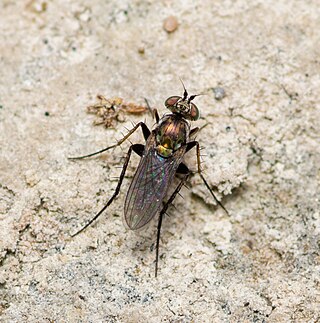
The Coelopidae or kelp flies are a family of Acalyptratae flies, they are sometimes also called seaweed flies, although both terms are used for a number of seashore Diptera. Fewer than 40 species occur worldwide. The family is found in temperate areas, with species occurring in the southern Afrotropical, Holarctic, and Australasian regions.

Campsicnemus is a genus of flies in family Dolichopodidae. There are more than 290 described species, made up of 34 Palearctic, 22 Nearctic, seven Afrotropic, 170 Australasian and Oceanian, and seven Indomalayan species. Some species endemic to the Hawaiian islands are characterized by their lack of wings. After the introduction of invasive ants and other alien species such as wild boar (Sus scrofa) to the islands, some of these flightless species are believed extinct.

Apterachalcus is a genus of flies in the family Dolichopodidae. It has only one described species, Apterachalcus borboroides, known from New Zealand. It was originally described by Harold Oldroyd in 1955, who placed the species in Acropsilus. However, Daniel J. Bickel determined that the species did not belong to Acropsilus, and created a new genus for it in 1991.

Paraclius is a genus of flies in the family Dolichopodidae. It is currently considered a polyphyletic assemblage of species.
Pelastoneurus is a genus of flies in the family Dolichopodidae.

Scellus is a genus of flies in the family Dolichopodidae. It is distributed in the Palearctic and Nearctic.

Tachytrechus is a genus of long-legged flies in the family Dolichopodidae.

Thinophilus is a genus of flies in the family Dolichopodidae. It includes about 146 described species distributed worldwide. Most species of the genus are found in coastal habitats, while a few species are found in freshwater habitats.

The Helosciomyzidae are a small family of flies found exclusively in the Southern Hemisphere. With the exception of the South American genus Sciogriphoneura, helosciomyzids occur only in Australia and New Zealand.

Hydrophorinae is a subfamily of flies in the family Dolichopodidae. Several molecular phylogenetic analyses of the family have found evidence that the subfamily in its current sense is polyphyletic.

Sciapodinae is a subfamily of flies in the family Dolichopodidae. Members of the subfamily possess several ancestral characteristics of the family, such as branched vein M1+2 in the wings (though M2 is absent or reduced in Mesorhagini) and a pedunculate hypopygium. They also typically have a deeply excavated vertex, giving their heads the appearance of a dumbbell when viewed from the front.

Diaphorinae is a subfamily of flies in the family Dolichopodidae.
Hydatostega is a genus of flies in the family Dolichopodidae. Most of its species are found in the Americas, where it is mainly restricted to montane habitats and high altitudes or latitudes, while three species are known from Tristan da Cunha, a group of islands in the South Atlantic Ocean. Hydatostega was formerly considered a synonym of Hydrophorus, but was recently restored as a separate genus.

Peloropeodinae is a subfamily of flies in the family Dolichopodidae. In some classifications, the genera of the subfamily are included in Sympycninae. According to a molecular phylogenetic analysis of the family Dolichopodidae by Germann et al. (2011), the subfamily is polyphyletic.

Sympycninae is a subfamily of flies in the family Dolichopodidae. In some classifications, this subfamily includes the genera of the subfamilies Peloropeodinae and Xanthochlorinae.
Coelopellini is a tribe of kelp flies in the family Coelopidae.
Coelopinae is a subfamily of kelp flies in the family Coelopidae.

Sciapodini is a tribe of flies in the family Dolichopodidae.












